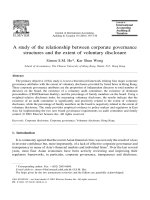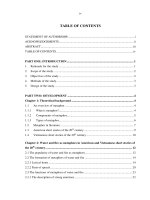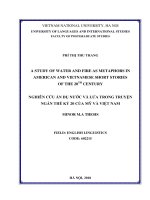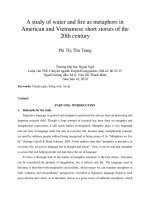A study of water and fire as metaphors in American and Vietnamese short stories of the 20th century
Bạn đang xem bản rút gọn của tài liệu. Xem và tải ngay bản đầy đủ của tài liệu tại đây (169.48 KB, 6 trang )
A study of water and fire as metaphors in
American and Vietnamese short stories of the
20th century
Phí Thị Thu Trang
Trường Đại học Ngoại Ngữ
Luận văn ThS. Chuyên ngành: English Linguistics; Mã số: 60 22 15
Người hướng dẫn: M.A. Văn Thị Thanh Bình
Năm bảo vệ: 2010
.
Keywords: Truyện ngắn; Tiếng Anh; Ẩn dụ
Content:
PART ONE: INTRODUCTION
1. Rationale for the study
Figurative language in general and metaphor in particular has always been an interesting and
inspiring research field. Though a large amount of research has been done on metaphor and
metaphorical expressions, it still needs further investigation. Metaphor plays a very important
role not only in language study but also in everyday life, because many metaphorical concepts
are used by ordinary people without being recognized or being aware of. In “Metaphors we live
by” (George Lakoff & Mark Johnsen, 2003: 4) the authors state that “metaphor is pervasive in
everyday life, not just in language but in thought and action”. Thus, it can be said that metaphor
is a powerful tool helping people use and enjoy the use of language.
To have a thorough look at the matter of metaphor, literature is the best choice. Literature
can be considered the product of imagination, but it reflects real life. The language used in
literature is therefore both imaginative and realistic, which means we can examine metaphors in
both “ordinary and extraordinary” perspectives. Nowhere is figurative language found in such
great amount and variety as in literature, and so is a great source of authentic metaphors, which
are employed to create imagery and enhance the powerful effect of the language use. In fact a
number of researchers have chosen literature as a means of studying language.
Among myriads of metaphorical concepts, I would like to have a close look at the use of
water and fire in literature for some reasons. First, water and fire are two essential elements of
life and of cultures, which appear in literature universally. It is believed that water represents the
East and fire the West, (Trần Ngọc Thêm, Nước, văn hoá và hội nhập,
Therefore, water and fire in cultural contexts is worth being researched. Second, water and fire
are also common metaphorical concepts in everyday communication. People sometimes integrate
water and fire in their communicative exchanges without realizing they are metaphors, for
example, “hot-tempered”, “heated discussion”, “tears streaming down”, or “flooding with work”.
Last but not least, I personally developed a great interest in the use of water and fire as
metaphors when I noticed that these two elements, though contrastive, sometimes denote the
same things. Such sentences as “Anger rushed over him” or “What you said added fuel to the
fire” are easily heard in everyday communication. They show that the abstract feeling of anger
can be expressed by two opposite things which are able to exclude themselves. Therefore, it is
fascinating to explore how water and fire metaphors are created in literature and used in real life.
To conclude, because there has not been any detailed research on the creation and use of
water and fire as metaphors in literature though water and fire in culture has been scrupulously
investigated, this study is hoped to contribute something to the research of metaphors in
literature and to the teaching and learning foreign literature of students of English.
2. Scope of the study
This paper mainly focuses on how water and fire metaphors are created in literature and
what they convey to the readers through an in-depth comparision between American short stories
and Vietnamese short stories of the 20
th
century from cultural and stylistic points of view. The
reason for that is metaphor and literature are such large researching fields that it is impossible to
cover the whole areas in the limited space of this paper.
To keep within the restriction of time and scale while ensure the ample language style a
collection of data from a variety of different American and Vietnamese short stories by
influential or recognized authors of the 20
th
century is assembled. The data must provide a wide
range of language use and style, with relatively modern language which is close to everyday
communication as well as maintains the distinguished feature of literature. Therefore 30
American stories and 30 Vietnamese stories of all stages of the 20
th
century are randomly picked
out as the database for this paper.
3. Objectives of the study
This paper is carried out in order to fulfill four main objectives:
To explore the use and formation of the metaphors of water and fire in the linguistic
perspective, basing on the data from American and Vietnamese short stories of the 20
th
century.
To compare water and fire metaphors in American and Vietnamese literatures.
To connect the use of water and fire as metaphors from the linguistic angle and from the
cultural viewpoint.
To suggest implications for teaching American literary texts to Vietnamese learners
whose major is English language.
4. Methods of the study
The overriding researching methods used to conduct this study are quantitative and
descriptive methods. In order to have an insight into the use and the creation of the metaphors of
water and fire in literature, the data collected from various short stories in both languages,
English and Vietnamese, are analyzed, synthesized and computed and finally documented. The
findings and conclusions of the paper are based on the facts and figures produced via these
methods.
5. Design of the study
This thesis paper is divided into three main parts, namely Introduction, Development and
Conclusion. The contents of these parts are presented as follows.
Part I introduces the rationale, scope, objectives, research methods and format of the study.
Part II includes two main chapters. Chapter 1 provides the theoretical background of the
study regarding major concerns in the area of metaphor and literature, and brief information
about American and Vietnamese short stories of the 20
th
century. Chapter 2 is the main focus of
the paper, which investigates the use of water and fire metaphors in American and Vietnamese
short stoires. It deals with the popularity, the creation and the functions of water and fire
metaphors.
Part III is the conclusion of the study in which a summary of the findings, pedagocial
implications for teaching and studying literature and suggestions for further studies will be made
in a brief manner.
REFERENCES
Books in Vietnamese
1. Diệp Quang Ban & Hoàng Văn Thung (2009), Ngữ pháp Tiếng Việt, Tập 1, Nxb Giáo dục, Hà
Nội.
2. Bộ giáo dục và đào tạo (2000), Văn học 12, Tập một, Nxb Giáo dục, Hà Nội.
3. Đinh Trọng Lạc & Nguyễn Thái Hoà (2009), Phong cách học Tiếng Việt, Nxb Giáo dục, Hà
Nội.
4. Phương Lan (2009), 20 truyện ngắn đặc sắc về Hà Nội, Nxb Lao động, Hà Nội.
5. Nguyễn Tuấn Thành (2009), Truyện ngắn hiện thực 1930-1945, Nxb Văn học, Hà Nội.
6. Nguyễn Tuấn Thành (2009), Truyện ngắn lãng mạn 1930-1945, Nxb Văn học, Hà Nội.
Books in English
7. Bendixen, Alfred & Nagel, James (2010), A Companion to the American Short Story, Wiley
Blackwell, UK.
8. Bigsby, Christopher (2006), The Cambridge Companion to Mordern American Culture,
Cambridge University Press, New York.
9. Dornyei, Zoltan (2007), Research Methods in Applied Linguistics, Oxford University Press,
Oxford.
10. Finegan, E. (2004), Language: Its structure and use, Thomson Wadsworth, USA.
11. Galperin, I. R. (1981), 23
rd
ed. Stylistics, Vyssaja Skola, Moscow.
12. Gibbs, Raymond W. Jr. (2008), The Cambridge Handbook of Metaphor and Thought,
Cambridge University Press, New York.
13. Goatly, Andrew (1997), The Language of Metaphors, Taylor & Francis Routledge, London
and New York.
14. Halliday, M.A.K. (1994), An Introduction to Functional Grammar, Edward Arnold, London.
15. Holme, Randal (2004), Mind, Metaphor and Language Teaching, Palgrave McMillan, New
York.
16. Kovecses, Zoltan et al. (2002), Metaphor: A Practical Introduction, Oxford University Press,
New York.
17. Lakoff & Johnson (2003), Metaphors we live by, University of Chicago Press, London.
18. Lakoff, G. & Turner, M. (1989), More Than Cool Reason: A Field Guide to Poetic Metaphor,
University of Chicago Press, USA.
19. Missikova, Gabriela (2003), Linguistic Stylistics, Filozoficka Fakulta, Univerzita Konstantina
Filozofa, Nitra.
20. Muller, Cornelia (2008), Metaphors Dead and Alive, Sleeping and Walking, University of
Chicago Press, Chicago and London.
21. Osmania University (1950), Collected Stories of William Faulkner, Random House, New
York.
22. Panther, K. et al. (2009), Metonymy and Metaphor in Grammar, John Benjamins Publishing
Company, Amsterdam and Philadelphia.
23. Picken, Jonathan D. (2007), Literature, Metaphor, and the Foreign Language Learner,
Palgrave McMillan, New York.
24. Richards. I. A. (1936), The Philosophy of Rhetoric. Oxford Univeristy Press, Oxford.
25. Scofield, Martin (2006), The Cambridge Introduction to the American Short Story,
Cambridge University Press, New York.
26. Stern, Josef (2000), Metaphor in Context, The MIT Press, Cambridge and Massachusetts.
27. Simpson, Paul (2004), Stylistics: A Resource Book for Students, Routledge, London and New
York.
28. Stefanowitsch, Anatol & Gries, Stefan Th. (2006), Corpus-based Approaches to Metaphor
and Metonymy, Mouton de Gruyter, Berlin.
29. Trường, H. T. (1993), Basic English Lexicology, National University Press, Hanoi.
30. Updike, John & Kenison, Katrina (2000), The best American Short Stories of the Century,
Houghton Fifflin Company, Boston and New York.
31. Wright, Laura & Hope, Jonathan (2005), Stylistics: A Practical Coursebook, Routledge,
London and New York.
32. Znamenskaya, T.A. (2004), Stylistics of the English Language, Mockba.
Websites
33. American Literature. Available at
34. History and Classification of Languages: The Monosyllabic, the Agglutinated and the
Inflected. Available at />Languages
35. Larsen, K. (2006), Do You Really Want to Set Me on Fire, My Love? : The Use of Internal
and External “Fire and Heat Metaphors” in some Rock Lyrics. Available at
36. Lửa và Nước. Available at />Va-Nuoc.html?VivvoSessionId=f60d3b470b1eb80a5384d82bd29c2399
37. Lửa Trong Đời Sống Văn Hoá Của Con Người. Available at
38. Nước, Văn hoá và Hội nhập. Available at
39. Online Short Stories. Available at
40. Online Short Stories. Available at
41. Online Short Stories. Available at
42. Online Short Stories. Available at
43. Online Short Stories. Available at
44. Phân loại các loại hình ngôn ngữ. Available at









